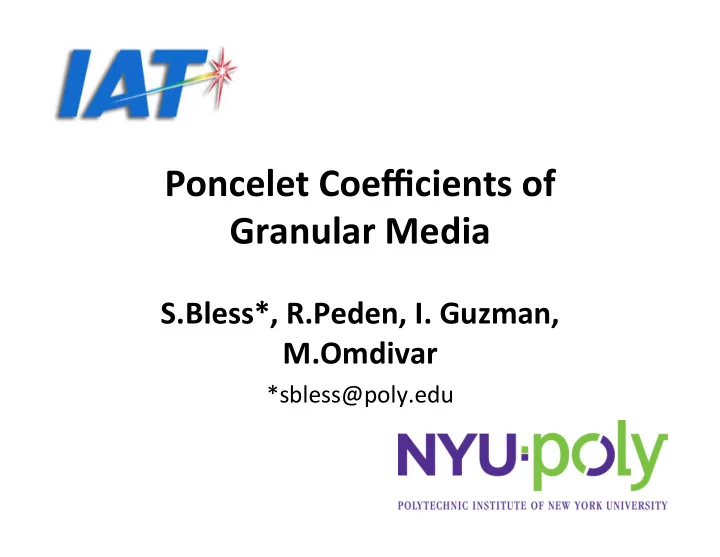

Poncelet Coefficients of Granular Media S.Bless*, R.Peden, I. Guzman, M.Omdivar *sbless@poly.edu
Background The mechanics of sand and other heterogeneous materials are of great interest nowadays. Data for high speed penetra;on of granular materials, however, is very sparse. A be?er data set, especially one that includes decelera'on , will be extremely useful for guiding and calibra;ng mechanical models. At NYU Polytechnic Ins;tute we are working to understand the cons;tu;ve behavior of sand and other materials: both for development of localized failure and for penetra;on resistance. Data from last ISB for rod decelera;on .
Materials 1)Natural Sand (O,awa 0.6 to 0.4 mm) 2)Water-saturated O?awa sand 3)Crushed quartz glass: 0.6 to 0.2 mm 4)Oil-saturated quartz glass (roughly 1:1 mixture of Krystal 40 from Petro- Canada and Purestol 7) The oil-saturated material is transparent.
Launch Techniques Later tests used steel spheres: Ini;al tests were with standard Compress gas gun launched 14-mm 12.7 mmM2 steel AP bullet, diameter steel ball bearing. downloaded for 300 m/s. Double diaphragm design, 10-W barrel.
Direct Measurement of Velocity Our goal is to measure velocity, from which a single differen;a;on yields force, which can be related to stress on the projec;le. Velocity is directly measured with a PDV (photon- Doppler-velocimeter) Two probes are mounding on the gun barrel for redundant recording. No surface prepara;on was necessary. circulator Laser 90:10 Probe PDV implementa'on Coupler Detector Retro- PDV schema'c Reflector
Results with AP bullet Ini;al tests were with powder gun and .50- cal steel bullet, downloaded to 300 m/s. PDV observes jacket stripping! However, very li?le decelera;on so it was not very useful for determining velocity- dependent force. Bullet observed for 100 mm penetra;on !
PDV Results for Sphere For dry sand, the PDV could follow the ball, oWen for a depth of 150-mm! For we materials, the view oWen became obscured by ejecta,
Test Matrix Shot ID Velocity (m/s) Target Density (g/cm 3 ) 1411 306 Quartz/oil 1.52 1413 303 Quartz/oil 1.52 1414 283 Quartz/oil 1.52 1436 183 Quartz/oil 1.52 1437 166 Quartz/oil 1.52 1429 300 Dense packed quartz 1.30 1430 303 Loose packed quartz 1.19 1420 299 Dense packed sand 1.82 1421 302 Dense packed sand 1.82 1426 270 Dense packed sand 1.82 1427 306 Loose packed sand 1.59 1428 299 Loose packed sand 1.59 1415 304 Water/sand loose 1.99 1418 302 Water/sand loose 1.99 1426 299 Water/sand dense 2.12 1424 303 Water/sand loose 2.12 1425 304 Water/sand loose 2.12
Cavity dynamics The impact shock if visible in the first two frames. The materials remains transparent in front of the projec;le. The cavity is ini;ally conical, but the expanding cavity is opaque.
Experimental results 1)The data for a given material are very reproducible. 2)At high velocity sand is harder to penetrate than fused quartz. 3)Dense materials were harder to penetrate than less dense materials. 4)Dry materials were harder to penetrate than saturated materials.
Poncelet equaNon The Poncelet Equa;on is a common framework for describing penetra;on in sand. The retarding force on the projec;le is dt = − AC ρ V 2 − AR F = M dV Here V is velocity, R is “strength”, A is presented area, 𝜍 is target density, and C is Poncelet drag (=0.5 ;mes conven;onal drag coefficient). The solu;on is ρ C ) exp − 2 ρ CAx ⎛ ⎞ V 2 = ( V 0 2 + R ⎟ − R ⎜ ⎝ ⎠ ρ C M The Poncelet equa;on used without the R term implies retar;ng force is just due to iner;al drag.
Dense Dry Sand 1)This material clearly shows a bifurca;on in behavior. It occurs at about the speed of sound in sand, and may represent a transi;on from supersonic to subsonic penetra;on. Shot Hi vel fits Low Vel FIts 1420 C=0.7, C=0.35, R=17MPs R=1.9MP a 1421 C=0.75, C=0.7, R=16MPa R=0.15M Pa 1426 C=0.9, C=0.9, R=16MPa R=0 2) This agrees with previous observa;ons of rod decelera;on in sand – both ours and Allen’s data. 3) For high velocity, Poncelet fit requires the a 16 MPa strength 4) Our data do not support DOP predic;on.
Loose Dry Sand 1)Transition not very evident in loose sand. 2)Loose Sand is well described by a Poncelet Fit with drag only over the whole velocity range.
Dense quartz glass 1) There is not compelling evidence for bifurcation in dense dry quartz glass. 2) Poncelet fit also requires substantial R (22GPa). 350 B Shot 1429, dense quartz 300 B B B B B B B B B B B 250 B B B B B B B B Velocity, m/s B B B B B 200 B B B B B B B B B B B B B B 150 B B B B B B B B B B B B B B B 100 B B B B B B B B B B B B B B B B B B B B B B 50 B B B 0 0 0.01 0.02 0.03 0.04 0.05 0.06 0.07 Penetration, m
Recommend
More recommend